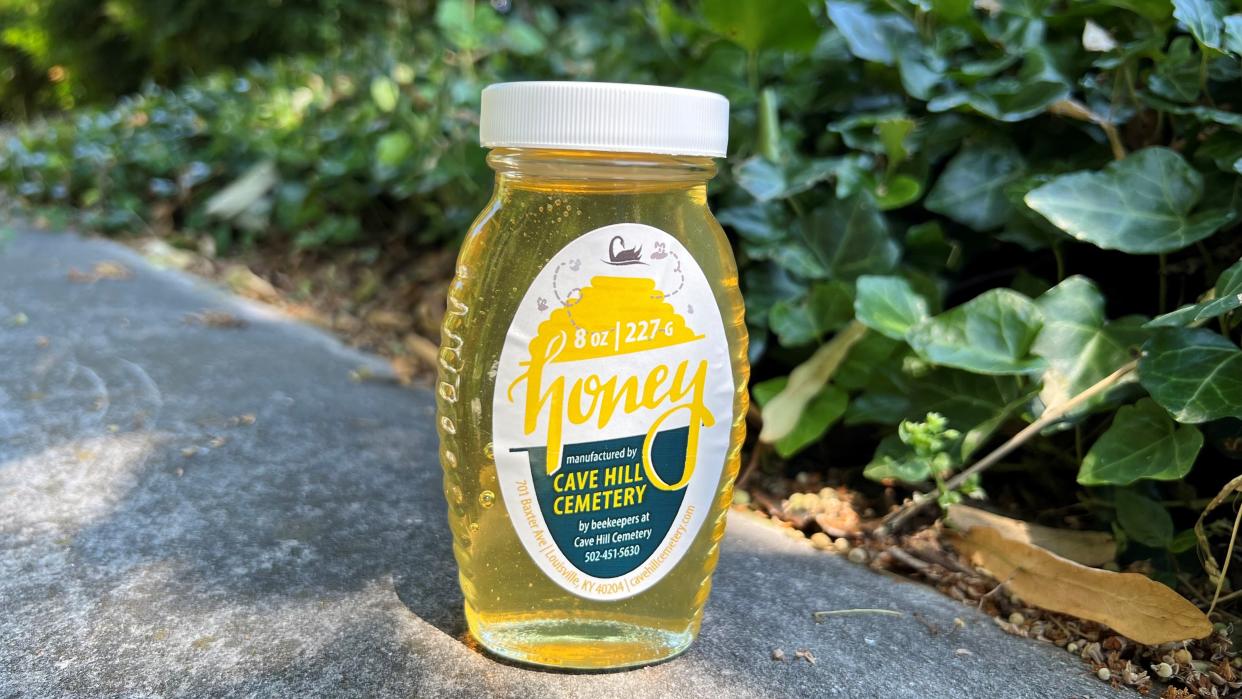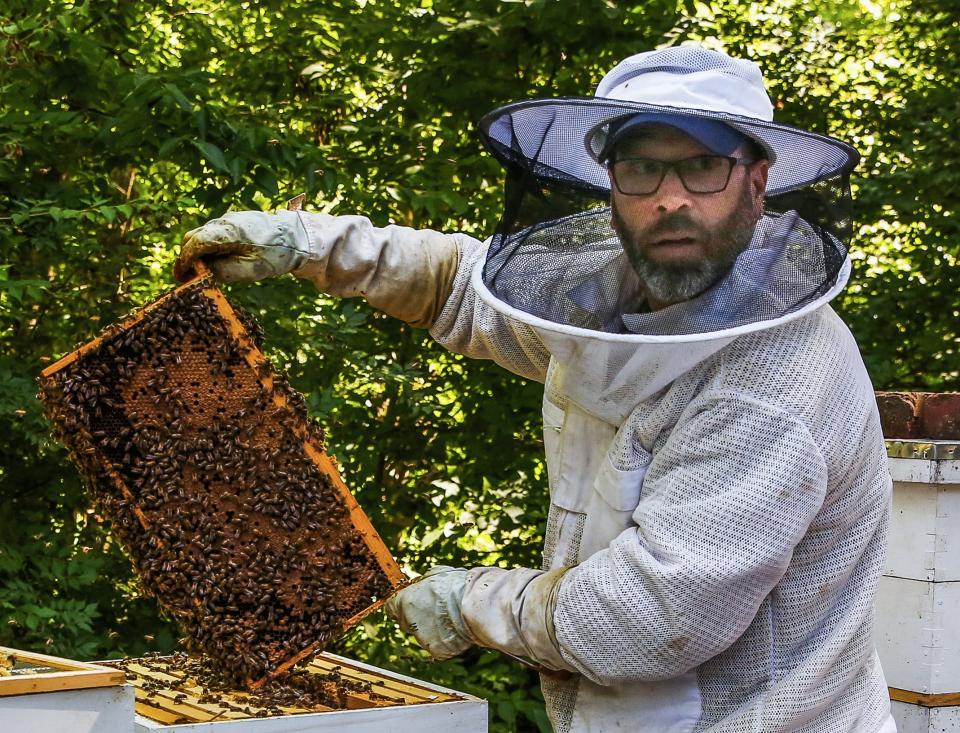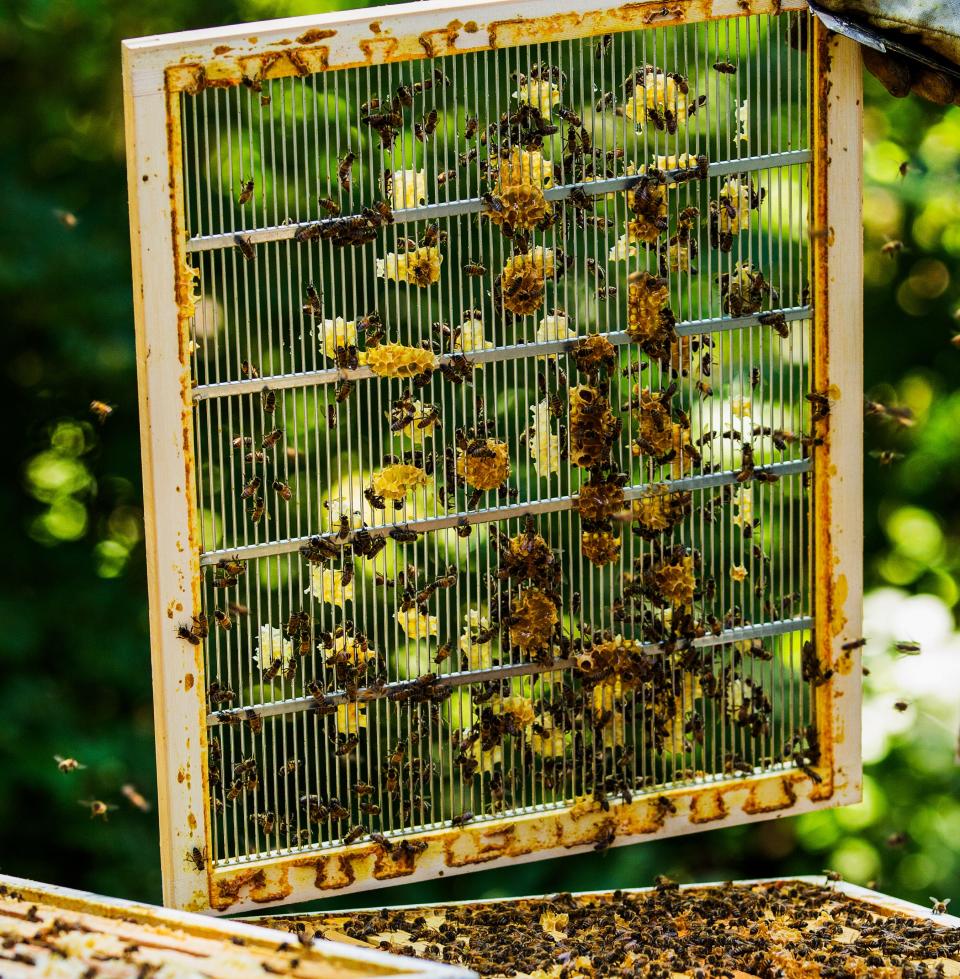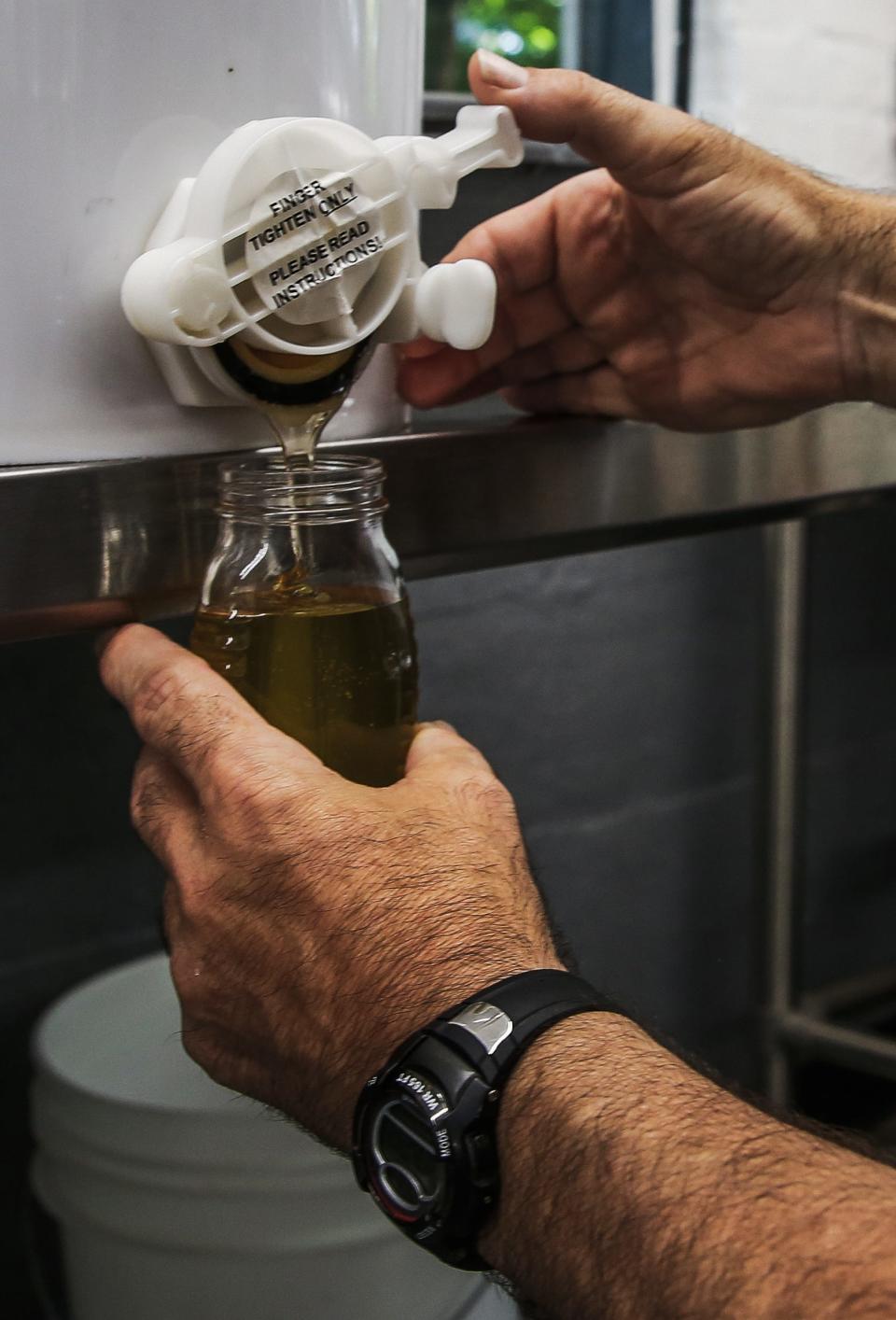What's a sweet surprise inside Cave Hill Cemetery? Just beekeeping and honey harvests

The historic Cave Hill Cemetery in the Highlands is well known as the final resting place of prominent citizens from Col. Harlan Sanders to George Rogers Clark and Muhammad Ali. It's also well-known as the largest cemetery in Kentucky, with expansive, beautiful 296-acre arboretum grounds.
What many people don't know about is a side project that Cave Hill Cemetery staff started in 2017 — beekeeping.
Turns out the cemetery's abundance of flowers and plant life and proximity to Beargrass Creek make it an ideal environment for honeybees.
Now, Cave Hill Cemetery has about 10 active beehives and produces about 900 pounds of honey per season, which runs from April to August. The honey is bottled and sold at the cemetery, with proceeds going to the Cave Hill Heritage Foundation. The honey even won a blue ribbon in the light amber honey category at last year's Kentucky State Fair.
Louisville restaurants: Here are 25+ Louisville eateries to take your out-of-town guests to when they visit
"The truth is the honey is a great product and a huge benefit, and we're all glad to get it, but it's about the bees," said Cave Hill apiarist Roger Martin. "It's about keeping the bees around, because I believe they are the most important insect on the planet."

Martin, who works as an arborist at Cave Hill and began tending bees in 2017, said he used to think the average price of honey was high. Now that he knows how much work goes into collecting honey, he understands.
"The amount of labor that goes into maintaining and caring for bees is a lot more than one might expect," he said. "So thank a beekeeper. The profitability isn't really there; they're doing it to maintain the bee population."
He also stressed that not all bees are scary or "need to be squashed the moment you see them."
"If it's a hot, sunny day, bees are going to be busy doing what bees do," he said.
Tucked away
Not far from the cemetery's Baxter Avenue entrance is a forest clearing covered in gravel and lined with logs. A sign warns guests against entry into "the bee zone," where 10 hives are set up in a row.
On a recent breezy summer Wednesday, Martin headed out to check on his hives, pulling on honey-stained gloves, a mesh net-covered hat and protective jacket. He headed to the third box in the row of hives, carefully removing the lid to peek inside.
"Ah, look at that, this is a good one," Martin said, pulling out a frame from the hive. "I am so excited to see this amount of bees in here!"

Hive boxes are usually made with two or three boxes stacked on top of each other. The bottom box is the deeper "brood box" where the queen bee lives and produces up to 3,000 eggs per day. Then a queen excluder, a wooden frame with small holes in it, goes on top to stop the queen from getting to the "medium supers," where worker bees will make honey. Each "super" has 10 slots for frames, which will slowly get loaded with honey.
More: Looking for locally produced honey? Here are 4 brands to try in the Louisville area
The third box was a special batch, Martin said, because they'd been caught in a swarm at the grave of venerated boxer Muhammad Ali.
"At the request of Lonnie Ali, we'd put a swam trap by the grave and caught these earlier this year," Martin said. "Look, the box even has a terrible rendition of a boxing glove. I'm really proud of these bees."
How the hives have grown
Cave Hill's bee hive program has grown from about three hives to 10, said Cave Hill Foundation manager Michael Higgs.
"From where we started just keeping hives, we have expanded by adding more pollinator gardens, changing what and where we plant and adding a honey house to the property," Higgs said. "The program is going exceptionally well, and it fit so well with us looking to advance our own sustainability practices."
Cave Hill isn't the only historic cemetery to take up beekeeping, either. Bellefontaine Cemetery in St. Louis, Missouri, and West Laurel Hill Cemetery in Bala Cynwyd, Pennsylvania, keep bees.
In New York, Woodlawn Cemetery in The Bronx makes honey and Green-Wood Cemetery in Brooklyn produces a honey called "The Sweet Hereafter."

The honey program at Cave Hill Cemetery started when independent beekeeper and Cave Hill partner Rodolfo Bernal began tending hives at Cave Hill, then encouraged cemetery staff to develop their own beekeeping team. He has mentored Cave Hill apiarist Roger Martin for the last five years or so and continues to assist with Cave Hill's honeybee program.
"I wanted to prove that city bees produce twice as much honey as country bees," Bernal said. "In the city, people have a variety of plants and they take care of the plants. So throughout the season, there is more honey in the city than there is honey in the country."
Bernal said it's beneficial to purchase local, raw honey because the pollens many people are allergic to are present in locally produced honey. Eating the honey regularly means a person is essentially taking "shots" of the allergen in small, manageable doses to build up an immunity. But commercially produced honey loses many of the health benefits and flavors when it is filtered, heated to high temperatures and shipped long distances.
'Up to the bees'
The Cave Hill beekeeping team collects honey three or four times a season, Martin said, with the largest honey yield — more than 400 pounds — coming in July. Once it's filtered and bottled, Cave Hill's honey is sold in the Heritage Foundation office and the Cave Hill main office in 8-ounce ($10) and 16-ounce ($13) bottles. Some people even buy it as gifts for mourners who are burying a loved one in Cave Hill Cemetery.
Martin said he would love to expand their honey production, but it's a hard crop to predict and extremely time-consuming to process.
"It's really, to be completely honest with you, up to the bees," Martin said. "I try to duplicate my habits season to season but sometimes they don't stop making honey and sometimes it's a little less. Inevitably whoever wants a jar of honey can get one."
You May Like:: 'At this point I'm drowning': Gluten-free cafe owner posts GoFundMe to save business
Features reporter Dahlia Ghabour covers food, dining trends and restaurants in the Louisville area. Send tips on new places or story ideas to dghabour@courier-journal.com or follow on Twitter @dghabour.
This article originally appeared on Louisville Courier Journal: Cave Hill Cemetery: Workers bee keep, store and sell honey

